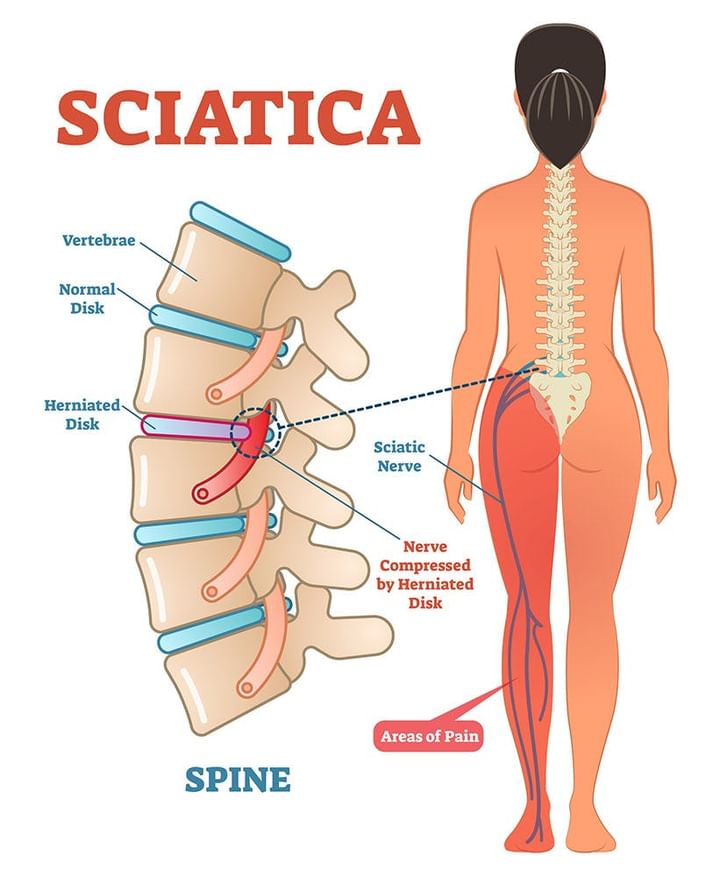Sciatica - Know How Homeopathy Can Help Curing It!
Sciatica refers to severely painful spasms along the sciatic nerve of the leg. This nerve runs from the back of the buttock and thigh, down the inside of the leg to the ankle. There is numbness and tingling.
The pain is caused by pressure on the sciatic nerve as it leaves the spinal column. Sciatica can have a variety of causes, including a herniated (slipped) disk in the spinal column, arthritis, neuritis, or a fall or trauma.
In most people who have sciatic, the disks in the backbone have become weakened, either with age or as a result of excessive strain. The disks and vertebrae provide the necessary flexibility for people to stretch and bend.
Each disk consists of a soft center, which acts as a shock absorber, and a tough fibrous outer layer. Sometimes, this outer layer weakens in parts, and the soft center bulges out. The resulting bulge puts pressure on the nerve to the leg and causes the pain of sciatica.
Any pressure on the sciatic nerve causes sharp, stabbing pains in the buttock and down the leg. It may happen suddenly when someone is bending or stretching or it may come on gradually. Even a slight movement, such as coughing or sneezing, can bring on the pain or make it worse.
For anyone suffering from sciatica, walking and sitting can be painful and difficult. The most comfortable position is lying on the back with knees bent.
What is the Sciatic nerve?
The sciatic nerve is the longest nerve of the body supplies to the lower legs.
The sciatic nerve originates from the sacral plexus. Sacral plexus is a nerve plexus which provides motor and sensory nerves for the posterior thigh, most of the lower leg and foot, and part of the pelvis. From sacral plexus, the sciatic nerve runs down to the hip, posterior aspect of the thigh to the knee. Behind knee joint, it divides into two branches tibial nerve and common peroneal nerve. These two branches run from knee to the foot.
What causes Sciatica pain?
Any type of irritation to the nerve in its course results in the pain and numbness in the area supplied by the nerve.
Causes include -
- Intervertebral disc herniation
- Spinal stenosis
- Pyriformis syndrome
- Pregnancy
Intervertebral disc herniation –
Intervertebral disc is the fibrocartilagenous structures lies between two vertebrae. Vertebrae are the interlocking bone that forms the spinal column which protects the spinal cord.
Intervertebral disc connects the vertebrae as well as allows movement of the spinal column. Disc has two parts outer fibrous ring and inner gel like structure called nucleus pulposus. This nucleus pulposus acts as a shock absorbing the gel and prevent the spinal cord from injury.
Due to the repeated injuries, this nucleus pulposus herniated from the intervertebral space and presses the sciatic nerve results in sciatica pain.
As the age progresses the elasticity of nucleus pulposus gets reduced and this limits the ability of the disc to absorb shock, ultimately irritation of the nerve and pain.
Spinal stenosis –
It is the narrowing of the spinal canal in which the spinal canal lies. Due to the narrowing nerve roots get compressed results in pain and numbness in the course of the nerve.
Pyriformis syndrome-
Sciatic nerves run beneath the pyriform muscle. Pyriform muscle is the muscle of the hip region. Due to the overuse of muscle this muscle gets irritated which affect the nerve also.
Pregnancy –
Sciatica may also occur during pregnancy as a result of the weight of the fetus pressing on the sciatic nerve during sitting or during leg spasms.
Symptoms of Sciatica
The onset may be sudden or gradual. The pain is felt in the buttock and radiates down the posterior aspect of the thigh and calf to the outer borders of the foot.
It is characterized by pain radiating down the back of the thigh that has been described as sharp, stabbing, electrical, and burning. The pain is worse on coughing or sneezing due to raised pressure in the spinal subarachnoid space. Parathesis and later numbness may be felt over the distribution of the sciatic nerve.
In severe cases, weakness of the calf muscles or foot drop may occur. Movement of the spine is limited. Due to intense pain, the patient may not be able to sleep.
Involvement of first sacral root causes- loss of ankle joint jerk, a weak planter flexion of the foot and sensory loss over the outer border of the foot.
Involvement of the fifth lumber root causes- weakness of the dorsiflexion of the toes and sometimes foot drop. Sensory loss occurs on the dorsum of the foot and lateral aspect of the leg. Here ankle joint is unaffected.
Involvement of the fourth lumber root causes-weakness of invasion of the foot and there is loss of knee jerk. Sensory loss is over the medical aspect of the leg. A valuable sigh in limitation of flexion of the thighs if the leg is kept straight at the knee.
These symptoms can manifest in one or both legs. The pain may be distributed uniformly along the pathway but, often, specific and intense spots of pain are predominant. In many cases, the pain of sciatica is accompanied by sensations of numbness, tingling, weakness, and achiness.
Generally, the sharp, stabbing pain comes on suddenly, reaches a high intensity, then gradually fades away. The burning sensation, which suggests a pinched nerve, is often felt anywhere on the lower back, buttocks, legs, and/ or feet. The electrical sensation usually radiates pain from the specific area where the nerve is compressed and, from there, down the sciatic nerve pathway.
It comes on suddenly, then disappears, only to return and repeat the cycle. The tingling and numbness are further indications of nerve irritation along the pathway. Finally, the achiness is associated with strained or ever worked muscles. The symptoms of sciatica can be more severe when the individual bends forward, coughs, or sneezes.
INVESTIGATIONS OF SCIATICA -
Tests are guided by the suspected cause of the dysfunction, as suggested by the history, symptoms, and pattern of symptom development. Investigations may include-various blood tests, X-rays, MRI, CT scan, and electromyogram.
- History – of trauma, exposure to damp or cold, sphincter control and history of the previous attack
- Physical examination – lumber spine include shape, mobility, muscle spasm.
- Other investigations include
- Imaging of spine – straight x-ray, MRI
- CSF – may show increased protein with normal cell count in the large protruded intervertebral disc.
- EMG – may be used to comfort the presence of denervation of affected muscles.
- Procaine injection test – for diagnosis of fibrostic pain
Treatment of Sciatica -
Sciatica due to slipped disk, while very unpleasant on some occasions and often disabling when it occurs, will usually improve on its own if the proper measures are taken.
The initial problem is to relieve the pain, and this is most easily done by resting in bed in the most comfortable position. It may be helpful to have the shoulders raised a little with pillows, which will ease the curve on the lower back since the muscles there will have gone into some spasms in response to the pain. All unnecessary movement must be avoided.
Continuous bed rest for two weeks, with the knees and the hip joints slightly flexed and sometimes with weight traction to the pelvis, is now the routine initial treatment for a slipped disk. Such treatment will reduce the disk herniation in 90% of cases. If it does not, surgery may be required.
Painkillers may be prescribed if the sciatic pain is particularly bad, but ordinary analgesic drugs such as aspirin or acetaminophen are usually adequate enough back rest is given. The crucial thing is to stay in bed and to resist the temptation to be up and about when the disk is only half healed; otherwise, the whole process will return to square one.
Often a hard bed is best because a soft bed encourages the spine to sag and puts more pressure on the intervertebral disks. Once sciatica has improved, it is equally important to avoid straining the back and lifting heavy objects.
Surgical treatment of sciatica is a last resort, usually for those who have had repeated episodes that have not improved with ordinary rest in bed and for those who cannot afford to take time off work.
However, surgery can be successfully performed only for certain types of a disk problem, so special X-rays of the spinal canal may need to be performed before a decision to operate can be made. In this test, called a myelogram, some special dye that shows up on X-ray is injected via a lumbar puncture into the fluid-filled space around the nerve roots.
The X-rays are taken then show up the shadow of the spinal cord and its nerve roots, and reveal whatever is causing the symptoms. From these pictures, the doctor can see whether surgery is possible and how extensive the surgery needs to be in order to solve the problem.
If the sciatica is caused by a single disk bulging out, the protrusion can be removed. If there are many disks producing pressure on the nerves, then more extensive surgery may be needed to relieve the pressure.
Homeopathy is one of the most popular holistic systems of medicine. The selection of remedy is based upon the theory of individualization and symptoms similarity by using a holistic approach.
This is the only way through which a state of complete health can be regained by removing all the sign and symptoms from which the patient is suffering.
The aim of homeopathy is not only to treat sciatica but to address its underlying cause and individual susceptibility. As far as therapeutic medication is concerned, several remedies are available to treat sciatica that can be selected on the basis of cause, sensations and modalities of the complaints.



+1.svg)
